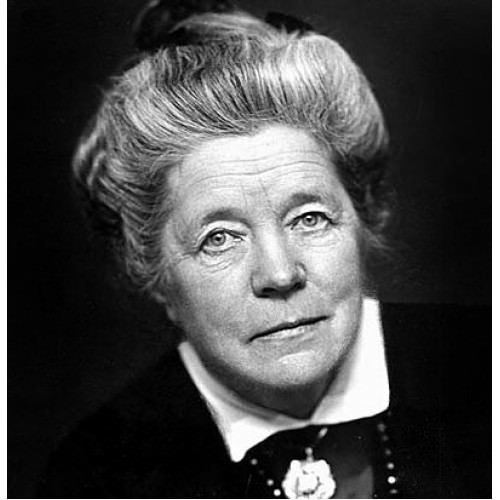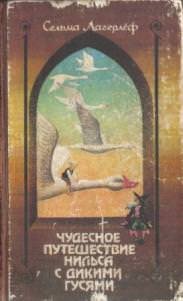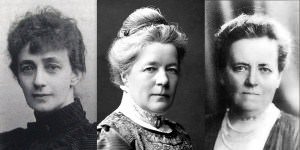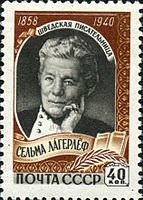
If in 1991 someone told me that Selma Lagerlöf was a woman, I would be very surprised, because I was convinced that the writer who created the «The Wonderful Adventure of Nils with" was a man. The name of "Selma" sounded to me more not like a lady’s one.
A brand new, just from the printing house book I received as a gift for some literary competition, held in the library. Although the surname and the name of the writer is not easy to remember, especially for children, for me that little triumph was so precious that when I repeated Selma Lagerlöf every day, I learned these two words in a week (and still remember them perfectly).
I had to google a lot on the Internet to find how my book looked like.

Well, who did not watch in childhood a cartoon about the adventures of Nils with geese? I think everyone who is now over 30 knows exactly what I'm talking about. By the way, it was one of my favorites.
But this post is neither about Nils, nor about the geese, but about their author.
To begin with, Selma Lagerlöf (born in 1858) was a citizen of Sweden, she spent her childhood in one very picturesque region of central Sweden called Värmland.

Troubles in life began for Selma at the age of 3 — she was paralyzed, so she could run-jump-explore the outside world only through her grandmother and aunt who surrounded her with care, and most importantly, made sure that the girl learned a lot about history, tribal legends, fairy tales, spirits and elves. Soon the grandmother died and it was a great loss for the child.
Then there was treatment in the hospital, after which, when Selma was 9, she was able to move, and from that age she started dreaming of becoming a writer. But her dreams were interrupted by the need to earn money, as the family was on the edge. Selma studied at the institute and began teaching.
The next loss for her was the death of her father. A couple of years later, she also had to sell the family house because of debts.
The beginning of Selma's creative career fell on the eighties: she received her first prize in a newspaper contest. The unfinished work was filled with romantic elements and fairy-tale subjects. This style Selma will carry through all her writing carreer. She went so deeply into her vocation that she left teaching and went on a trip to Italy, where she continued to write.
"The Adventures of Nils" brought Selma the greatest glory. The book so harmoniously interwove local culture, traditions, geography with human feelings, that it was delighted not only by children, but also by adults. And all this was presented in the form of a fairy tale. After the book’s publication, Lagerlöf was recognized as a talented author not only in the territory of her native country, but also at the world level. In 1909 she received the Nobel Prize "as a tribute to high idealism, bright imagination and spiritual penetration, which distinguish all of her works." By the way, Selma was the first woman to receive such a high award in the literature section.
Taking advantage of her financial opportunity, the writer bought the familty residential house she sold once and lived there for the rest of her life (until 1940).
Selma was very fond of her country and even gave her gold a medal to the treasury to save the situation in the Soviet-Finnish conflict. Fortunately, the government found other sources of income and returned the medal back.
Selma did not leave offspring in this world, because she was homosexual. It turned out only in half a century from her death due to her letters, which were published publicly (she bequeathed the opening of her archive only in 1990), and before that she was simply considered lonely. For 40 years, she maintained contact with Valborg Olander, who fought for women's rights, and also Selma had an affair with Sophie Elkan (a writer). In Sweden, there was shot a film about the three of them.

Sophie Elkan — Selma Lagerlöf — Valborg Olander
It was a love triangle: the feminist Olander, knowing that Selma and Elkan had a relationship, decided to make Lagerlöf love her in another way. At first she agreed to the role of just a friend, and gradually took control of the writer's economy, correspondence and finances, so she became irreplaceable. Selma, apparently, loved them both and was "torn" to pieces because of that.
When Elkan died of cerebral hemorrhage, it seemed that Selma and Olander could live together happily, but Selma was overwhelmed by a depressed state due to the loss of a person close to her. She grieved so much that did not pay attention to Olander, the latter was very jealous because of that. But time cures everything: severity of the loss diminished and Selma again became close with Olander. Since then, they stayed together.
At that time homosexual relations in Sweden were considered to be punishable, therefore such communications were kept in secret. The writer hoped that in 50 years the situation with same-sex relationships would change, therefore, she appointed the opening of her letters after five decades.
The contribution of Lagerlöf to the culture of Sweden was so great that in addition to the monuments and creation of a museum from her house, the government decided to depict her portrait on a banknote of 20 crowns. In the USSR Lagerlöf was also honored memory — there was designed a stamp with her portrait.

Resteemed by @resteembot! Good Luck!
Curious?
The @resteembot's introduction post
Get more from @resteembot with the #resteembotsentme initiative
Check out the great posts I already resteemed.
Downvoting a post can decrease pending rewards and make it less visible. Common reasons:
Submit
Thank you for the swedish history, Im glad she was liked out side of sweden as well! I to liked her! :)
Downvoting a post can decrease pending rewards and make it less visible. Common reasons:
Submit
Thanks for reading!)
Downvoting a post can decrease pending rewards and make it less visible. Common reasons:
Submit